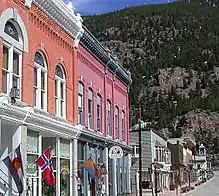Georgetown–Silver Plume National Historic Landmark District | |
 The Georgetown Loop high bridge as seen c. 1885. | |
  | |
| Nearest city | Georgetown, Colorado and Silver Plume, Colorado |
|---|---|
| Coordinates | 39°41′55″N 105°42′48″W / 39.69861°N 105.71333°W |
| Area | 3,288 acres (1,331 ha) |
| Built | 1859 |
| Architectural style | Late Victorian |
| NRHP reference No. | 66000243 |
| CSRHP No. | 5CC.3 |
| Significant dates | |
| Added to NRHP | November 13, 1966[1] |
| Designated NHLD | November 13, 1966[2] |


The Georgetown–Silver Plume National Historic Landmark District is a federally designated United States National Historic Landmark that comprises the Town of Georgetown, the Town of Silver Plume, and the Georgetown Loop Historic Mining & Railroad Park between the two silver mining towns along Clear Creek in the Front Range of the Rocky Mountains in Clear Creek County, Colorado, United States.
The district includes well-preserved examples of the buildings and mining structures of the Colorado Silver Boom from 1864 to 1893. The Georgetown Loop Historic Mining & Railroad Park includes the reconstructed Georgetown Loop, a spectacular example of 19th-century 3 ft (914 mm) narrow gauge railway engineering required to negotiate the 601 feet (183 meters) of elevation rise in the mere 2.0 miles (3.2 kilometers) between the two towns. Historic steam locomotives pull passenger trains over the loop from late May through the beautiful Autumn colors of early October. Guided tours of the Lebanon Silver Mine are also available.
The district was designated a National Historic Landmark on 1966-11-13.[2][3]
History
Gold was discovered in Georgetown by George and David Griffiths in 1859, and Georgetown eventually took its name from the former. The gold finds in the area were relatively minor, but a major lode of silver was discovered in 1864, kicking off the local boom. Georgetown became a center for thousands of miners operating in the surrounding hills. Silver Plume was developed as one of a series of satellite camps, and in 1884 the Georgetown Loop Railroad was built, connecting the two by rail. Mining declined in the 1890s, and the area has since had a relatively low population.[3]
See also
References
- ↑ "National Register Information System". National Register of Historic Places. National Park Service. January 23, 2007.
- 1 2 "Georgetown–Silver Plume National Historic Landmark District". National Historic Landmark summary listing. National Park Service. Archived from the original on January 4, 2008. Retrieved October 13, 2007.
- 1 2 Joseph S. Mendinghall (May 1975) National Register of Historic Places Inventory-Nomination:, National Park Service and Accompanying 41 photos, from 1975 and undated.
External links
![]() Media related to Georgetown-Silver Plume Historic District at Wikimedia Commons
Media related to Georgetown-Silver Plume Historic District at Wikimedia Commons